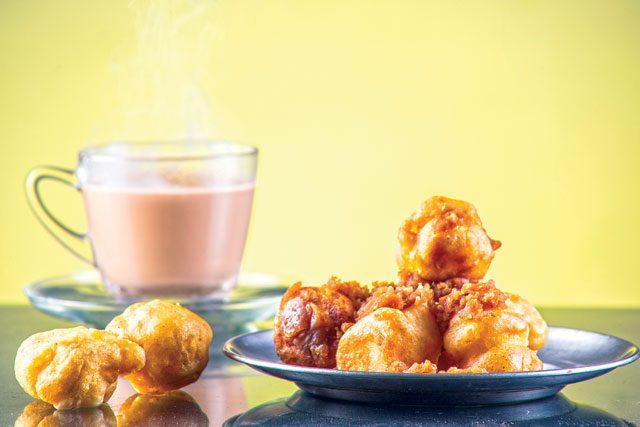A breakfast favorite, full of delicious memories to relive or create anew.

If you are anything like me, the last thing you want to do in the morning is get out of bed. You’re warm and comfortable, and you are probably still halfway in dreamland. Getting up just seems cruel. The only thing that makes getting up marginally better is the thought of breakfast. People around the world have different ideas of breakfast. For some it means oats and cereals, for some it brings memories of eggs and bacon, and for some others still, its rice and vegetables (Rice for breakfast? Yes, I’m as outraged as you). But, for me, breakfast has always meant strongly brewed milk tea with some hot gwaramari.
Gwaramari is a traditional Newari food item that’s made up of fried balls of puffy dough. The word gwaramari comes from “gwara” which means round, and which means bread.
Gwaramari brings out a lot of memories, especially of the winter months. As a kid, I would always spend my winter vacations at my grandmother’s, and my fondest memories are of fighting overgwaramari with my brother and my cousins. Every morning, my uncle would go out for his morning walk and return with a pink or green or bluepolythene bag full of gwaramari. My grandma would already have the tea ready, and all us kids would dig in with our feet still inside the blanket.
The best (and only) time to eat them is in the morning. Even tea shops agree with me. If you go in after nine to buy gwaramari, you’ll have to return sorely disappointed. The perfect gwaramari is crispy on the outside and soft and airy on the inside, with just a hint of salt. They are best accompanied by some milk tea. In fact, gwaramari wouldn’t taste half as good without some chiya for company.
There is a very specific way of eating gwaramari, especially if you’re still a five-year-old at heart. First of all, you select the biggest gwaramari in front of you, so that no one else can have it. Then, you carefully break it in half. Now, you press the inside of the gwaramari towards the edges till you have a makeshift bowl. Use the bowl to spoon the hot tea into your mouth, and then eat the soppy gwaramari half, as well. Repeat with the other half.
If you’re craving some gwaramari, and your kitchen skills aren’t too shabby, here’s how you make them. Gwaramari isn’t very difficult to make, and the ingredients are all usually found in your home. If you want some gwaramarifor the morning, you best start preparing the batter the evening before. Take some plain flour in a mixing bowl, and add a couple of spoonfulsof baking soda and a spoonful each of salt and cumin. Then, slowly add water and mix thoroughly until you get a very thick batter. Cover and leave overnight.
The next morning, your batter will have had some time to puff up, giving the gwaramari its distinct airy texture. Now, heat enough vegetable oil in a kadhai (wok) to deep fry the batter. You can use some methi(fenugreek) seeds to check if the oil is hot enough. Throw in a few seeds, and if they turn black, your oil is hot enough for you to start frying your gwaramari.
Take a small ball of batter and carefully drop it in the oil. Continue doing this as long as there is some space in the wok. Fry these balls on all sides till they are golden brown all over. Then, remove them from wok and let them rest on a newspaper. Once they have cooled enough for you to touch without crying out in pain, dig in immediately.
Now if you would rather not bother with cooking, you can still easily get gwaramari. Most tiny tea shops spread across old narrow lanes around Patan and Kathmandu’s durbar squares have gwaramari frying early in the morning. Try to get there early. As I mentioned earlier, after nine, you might have to return empty handed. If you’re in Patan, I would recommend this one particular shop that’s rather popular for its gwaramari. It’s a dingy little shop in a galli between Kwalkhu and Dhaugal. You might have to wait, as there is usually a crowd, especially on the weekends. But the gwaramari there is worth it.
Whether you love to cook, or you’d rather buy than burn down your kitchen, don’t miss out on these wonderful balls of delight.










